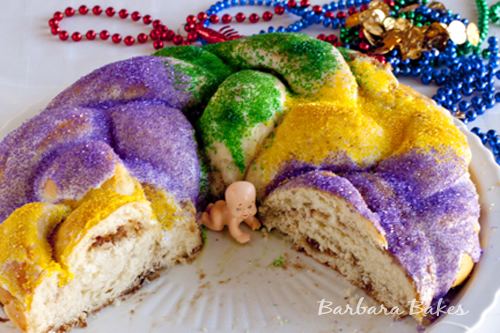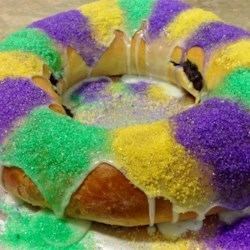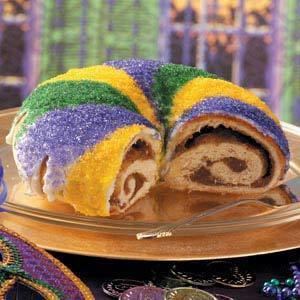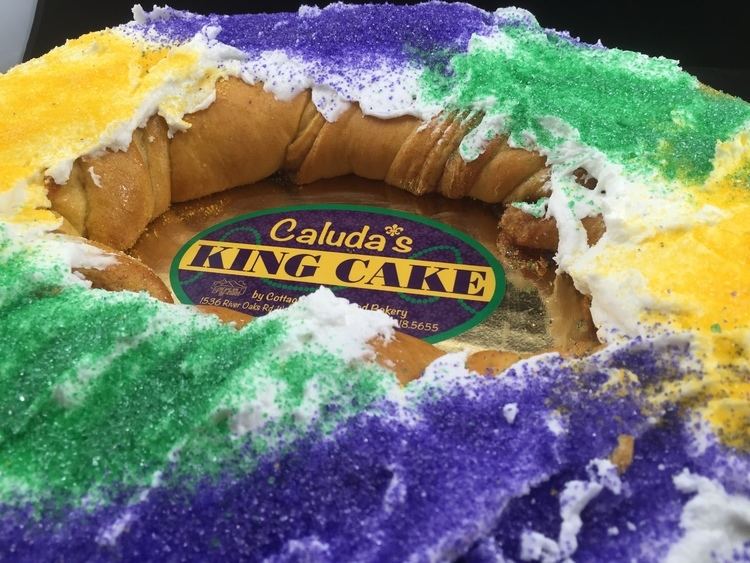Type Cake | ||
 | ||
Alternative names Kingcake, kings' cake, king's cake, three kings cake, galette des rois Similar dishes jésuite
tarte conversation Similar Galette, Rosca de reyes, Frangipane, Tortell, Bolo Rei | ||
How to make a mardi gras king cake southern living
A king cake (sometimes shown as kingcake, kings' cake, king's cake, or three kings cake) is a type of cake associated in a number of countries with the festival of Epiphany at the end of the Christmas season; in other places, it is associated with the pre-Lenten celebrations of Mardi Gras/Carnival.
Contents
- How to make a mardi gras king cake southern living
- People eat king cakes for the first time
- History
- French king cake
- King cake in Spanish speaking countries
- Gulf Coast king cake
- New Orleans
- Trinket
- Ingredients and recipes
- References
What started out roughly 300 years ago as a dry French bread–type dough with sugar on top and a bean inside now comes in many varieties depending on the country. Some king cakes are made of a sweet brioche dough in the shape of a hollow circle with a glazed topping sprinkled with colored sugar. Hundreds of thousands of King Cakes are eaten in New Orleans during the Carnival season. In other countries, king cakes are made with a puff pastry, filled with one of several fillings (e.g., almond, apple, chocolate/pear, etc.), and have a small figurine hidden inside. The figurine changes from bakery to bakery and often represents a hit movie or other cultural icon.

The cake often has a small plastic baby (to represent the Baby Jesus) inside or underneath; and the person who gets the piece of cake with the trinket has various privileges and obligations.

People eat king cakes for the first time
History

The "king cake" takes its name from the biblical kings. In Western Christian liturgical tradition, the Solemnity of Epiphany—commemorated on January 6—celebrates the visit of the Magi to the Christ Child. The Eve of Epiphany (the night of January 5) is popularly known as Twelfth Night (the Twelve Days of Christmas are counted from Christmas Eve until this night). The season for king cake extends from the end of the Twelve Days of Christmas (Twelfth Night and Epiphany Day), up until the end of Shrovetide: Mardi Gras, "Fat Tuesday," or Shrove Tuesday; the day before the start of Lent. Some organizations or groups of friends may have "king cake parties" every week through the Carnival season. In Portugal and France, whoever gets the King cake trinket is expected to buy the next cake for these get-togethers.
It is a popular food item during the Christmas season (Christmas Eve to Epiphany) in Belgium, France, Quebec and Switzerland (galette or gâteau des Rois or galette des rois), Portugal (bolo rei), Spain and Latin America (roscón or rosca de reyes) and, Greece and Cyprus (vasilopita) and Bulgaria (banitsa). In the United States, Carnival is traditionally observed in the Southeastern region of the country, particularly in New Orleans, Bay Saint Louis, Mobile, Pensacola, Galveston, and other towns and cities of the Mississippi Gulf Coast.
In these regions, the king cake is closely associated with Mardi Gras traditions and is served throughout the Carnival season, which lasts from Epiphany Eve to Fat Tuesday. The King Cake tradition is thought to have been brought to New Orleans from France in 1870. Now, as part of the celebration, it is traditional to bake a cake (King Cake) in honor of the three kings. The official colors of Mardi Gras – created in 1872 by the Krewe of Rex – are purple for justice, green for faith, and gold for power.
Related culinary traditions are the tortell of Catalonia, the gâteau des Rois or reiaume in Provence or the galette des Rois in the northern half of France, and the Greek and Cypriot vasilopita. The galette des Rois is made with puff pastry and frangipane (while the gâteau des Rois is made with brioche and candied fruits). A little bean was traditionally hidden in it, a custom taken from the Saturnalia in the Roman Empire: the one who stumbled upon the bean was called "king of the feast." In the galette des Rois, since 1870 the beans have been replaced first by porcelain and now by plastic figurines.
Samuel Pepys recorded a party in London on Epiphany night, 6 January 1659/1660, and described the role the cake played in the choosing of a "King" and "Queen" for the occasion: "...to my cousin Stradwick, where, after a good supper, there being there my father, mothers, brothers, and sister, my cousin Scott and his wife, Mr. Drawwater and his wife, and her brother, Mr. Stradwick, we had a brave cake brought us, and in the choosing, Pall was Queen and Mr. Stradwick was King. After that my wife and I bid adieu and came home, it being still a great frost." The choosing of King and Queen from the pie, usually by the inclusion of a bean and a pea, was a traditional English Twelfth Night festivity. The cake was called a "Twelfth Cake", "Twelfth-night cake", or "Twelfth-tide cake".
French king cake
The cake traditionally celebrating Epiphany in France and Quebec is sold in most bakeries during the month of January. Three versions exist: in northern France, Quebec, and Belgium the cake called galette des rois in French or Koningentaart in Flemish/Dutch (which can be either circular or rectangular) consists of flaky puff pastry layers with a dense center of frangipane or apple. In the west of France a sablé galette is made, a form of sweetcrust pastry. In southern France—Occitania, Roussillon, Provence, Catalan where it is called tortell—the cake called gâteau des rois or royaume, is a torus-shaped brioche with candied fruits and sugar, similar in its shape and colors to a crown. This later version is also common to Spain and very similar to New-Orleans king cake.
Tradition holds that the cake is “to draw the kings” to the Epiphany. A figurine, la fève, which can represent anything from a car to a cartoon character, is hidden in the cake and the person who finds the trinket in his or her slice becomes king for the day and will have to offer the next cake. Originally, la fève was literally a broad bean (fève), but it was replaced in 1870 by a variety of figurines out of porcelain or—more recently—plastic. These figurines have become popular collectibles and can often be bought separately. Individual bakeries may offer a specialized line of fèves depicting diverse themes from great works of art to classic movie stars and popular cartoon characters. The cakes are usually sold in special bags, some of which can be used to heat the cake in a microwave without ruining the crispness of the cake. A paper crown is included with the cake to crown the "king" who finds the fève in their piece of cake. To ensure a random distribution of the cake shares, it is traditional for the youngest person to place him- or herself under the table and name the recipient of the share which is indicated by the person in charge of the service.
Formerly, the cake was divided into as many shares as there were guests, plus one. The latter, called "the share of God," "share of the Virgin Mary," or "share of the poor" was intended for the first poor person to arrive at the home.
King cake in Spanish-speaking countries
The roscón de reyes in Spain or rosca de reyes in Latin America is traditionally eaten on January 6, during the celebration of the Día de los reyes magos (Epiphany or the "Day of the Three Wisemen"). In most of Spain, Mexico and in Latino communities in the United States, this is the day when children get presents from the Three Wise Men. Before going to bed, children in Mexico leave a shoe outside their home, filled with hay or dried grass and a bowl of water as a present for the animals the reyes ride, along with a note for the reyes. The roscón de reyes has an oval shape to symbolize a crown. For decoration, people sometimes use dried and candied fruits such as figs, quince or cherries. The fruit symbolizes the many jewels that a crown would have.
The tradition of placing a bean, candy or figurine of the baby Jesus inside the cake is followed. Whoever finds it must take it to the nearest church on February 2, Día de la candelaria (Candlemas Day), which celebrates the presentation of Jesus in the Temple. According to the Jewish tradition, an infant was to be presented to God in the Temple forty days after his birth. The use of candles on Candlemas represents the light of Christ presented to the world. In Mexico and the Mexican diaspora in the United States, people who find the baby Jesus figurine in their piece of cake usually agree to host a party on Candlemas (February 2) and to provide the guests with tamales and atole.
In Argentina, the tradition of consuming a rosca on January 6 is also followed, although no figurine is included. In addition, a similar version with whole cooked eggs on top of the cake is also served on Easter as rosca de Pascua.
In some places, the rosca de reyes is replaced by panettone.
Gulf Coast king cake
In the southern United States, the tradition was brought to the area by Basque settlers in 1718. Originally, it was a cinnamon-filled bready cake eaten to celebrate Epiphany, but it is now associated with Carnival (also known as Mardi Gras). Celebrated across the Gulf Coast region from the Florida Panhandle to East Texas, King cake parties are documented back to the 18th century.
The king cake of the Louisiana tradition comes in a number of styles. The most simple, said to be the most traditional, is a ring of twisted cinnamon roll-style dough. It may be topped with icing or sugar, which may be colored to show the traditional Mardi Gras colors of green, yellow, and purple. King cakes may also be filled with additional foodstuffs, the most common being cream cheese, praline, cinnamon, or strawberry. A so-called "Zulu King Cake" has chocolate icing with a coconut filling, because the Krewe of Zulu parade's most celebrated throw is a coconut. Some bakers now offer king cakes for other holidays that immediately surround the Mardi Gras season, such as king cakes with green and red icing for Christmas, cakes with pink and red icing for Valentine's Day, and cakes with green and white icing for St. Patrick's Day. Others have gone a step further and produce specialty king cakes from the beginning of football season for Louisiana State University and New Orleans Saints tailgate parties, then for Halloween, then Thanksgiving—and do not cease until after Mardi Gras season, when they produce an Easter holiday king cake.
In the Southern culture, whoever finds the trinket must provide the next king cake or host the next Mardi Gras party.
New Orleans
Starting on Epiphany on January 6, residents begin holding parties especially dedicated to King Cake. King Cake parties bring families and community members together to celebrate the season of Mardi Gras, with its krewe parades and festivals. King Cake is so symbolic of the Mardi Gras celebration for residents it is believed that consuming King Cake outside of the Carnival season will result in rain on Mardi Gras day. The dessert’s “search for the baby,” the small figurine located inside the cake, is a fun way for residents of New Orleans to celebrate their Christian faith.
The dessert’s significance to the city was evident in the first Mardi Gras season (2006) after Hurricane Katrina: thousands of King Cake orders flooded bakeries both inside and outside of Louisiana, an example of how significant the dessert’s tradition is both inside and outside of the region.
Some sports teams around the area have also infused the tradition of the king cake baby into their teams. The Miami Marlins AAA minor league baseball affiliate, formerly known as the New Orleans Zephyrs, changed their name to the New Orleans Baby Cakes, starting in the 2017 season. The New Orleans Pelicans introduced the King Cake Baby as a second mascot during games around Mardi Gras, to accompany their main mascot, Pelican Pierre.
Trinket
Traditionally, a small plastic or porcelain baby is hidden into the king cake. Originally, the baby was placed into the cake to symbolize baby Jesus. Fava beans were also used to represent Jesus.
Today, the baby symbolizes luck and prosperity to whoever finds it in his/her slice of cake. In some traditions, the finder of the baby is designated “king” or “queen” for the evening. That person is also responsible for purchasing next year’s cake, or for throwing the next Mardi Gras party.
Many bakers have recently been placing the baby outside of the cake, and leaving the hiding to the customer because there is a potential of customers choking on or swallowing the baby, and bakers want to stay clear of this liability.
Ingredients and recipes
There are many different recipes for king cake. However, the most common ones include: milk, butter, yeast, water, brown and white sugar, eggs, salt, nutmeg, flour and cinnamon. The frosting is typically made from confectioner's sugar, water, lemon juice, and colored sugar crystals.
The colors of the king cake originally came from the Christian religion. The purple symbolizes justice, the green symbolizes faith, and the gold symbolizes power. The three colors honor the three kings who visited the Christ child (Jesus) on Epiphany, the 12th day after Christmas.
